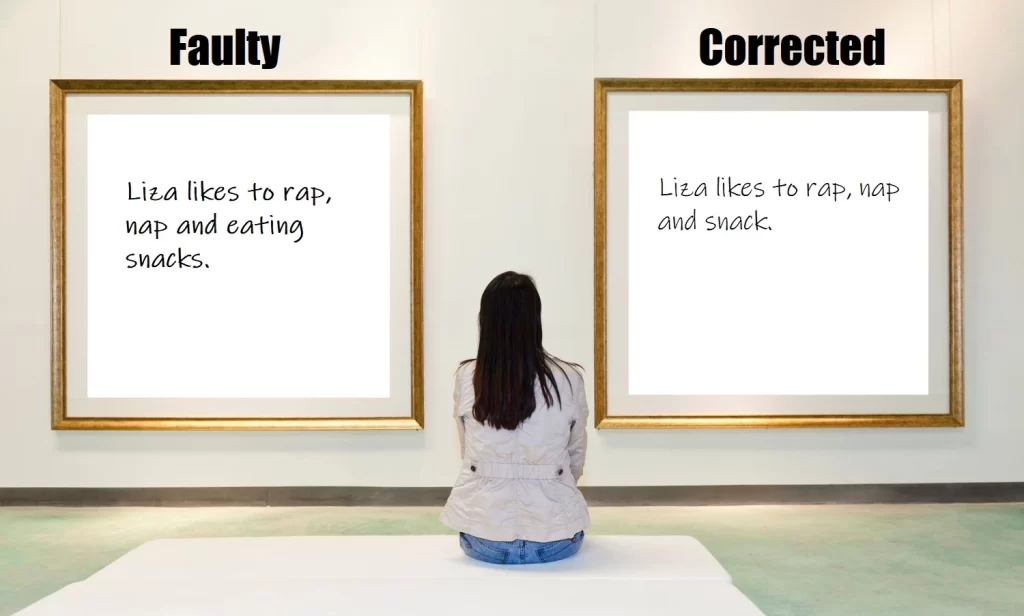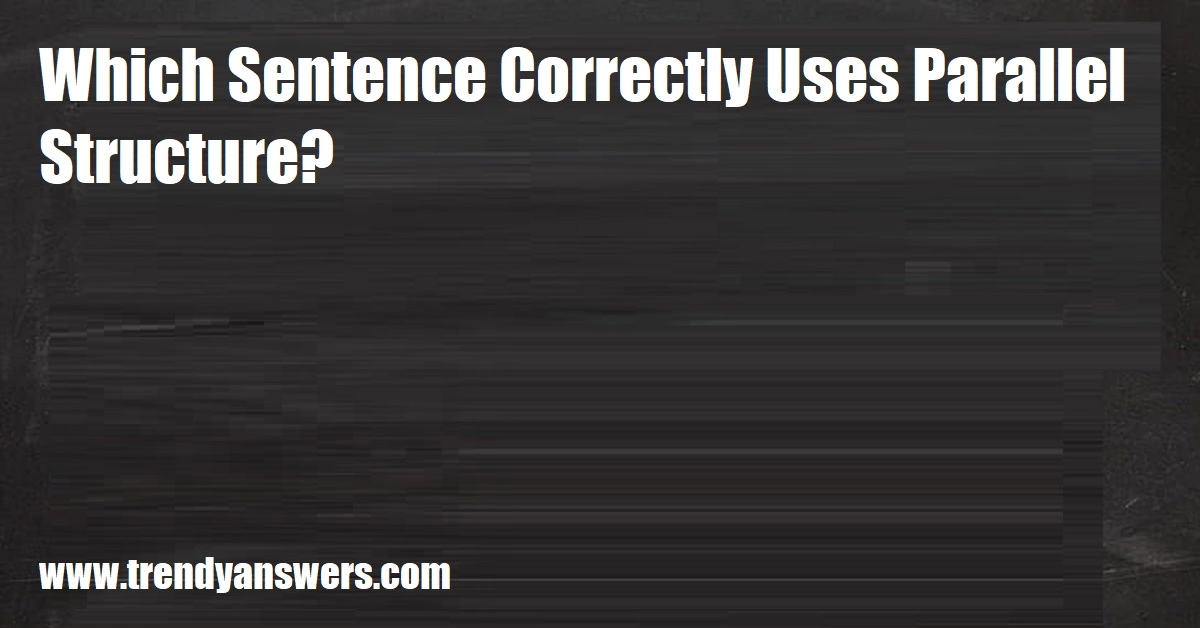Have you ever read a sentence that felt perfectly balanced and pleasing to the ear? Chances are, it followed the rules of parallel structure. Parallel structure, also known as parallelism, is an essential aspect of English grammar that adds harmony and coherence to your writing. In this article, we will explore Which Sentence Correctly Uses Parallel Structure and use of correct parallel structure and its significance in creating well-crafted sentences.
What is Parallel Structure?
Parallel structure involves using grammatical and structural consistency within sentences or phrases. This means arranging similar ideas in a parallel manner, resulting in a smooth and polished flow. When sentences are parallel, readers can better understand the relationships between ideas, making the overall message more impactful and memorable.
For instance, consider this non-parallel sentence: “He likes hiking, to swim, and running.” Now, let’s transform it into a parallel sentence: “He likes hiking, swimming, and running.” The parallel version sounds more balanced and engaging, enhancing the reader’s experience.
Also Read: Which Sentence Should Be Revised to Reduce Wordiness?
The Rules of Parallel Structure
To achieve parallelism, writers must follow specific rules:
- Subject-Verb Agreement: Ensure that the subjects and verbs in your sentence match in terms of tense and plurality.
- Incorrect: “She enjoys hiking and to swim.”
- Correct: “She enjoys hiking and swimming.”
- List Items: When presenting a list of items, keep them in a consistent grammatical form.
- Incorrect: “He prefers reading books, watching television, and to play video games.”
- Correct: “He prefers reading books, watching television, and playing video games.”
- Correlative Conjunctions: Words like “either…or,” “neither…nor,” “both…and,” etc., require parallelism in the structures that follow them.
- Incorrect: “The project manager is either skilled at delegation or making quick decisions.”
- Correct: “The project manager is either skilled at delegation or skilled at making quick decisions.”
Also Read: How Many Grams in a Kilo: Understanding Metric Measurements
Why Use Parallel Structure?
Parallel structure serves multiple purposes that elevate the quality of your writing:
- Clarity and Readability: Parallel sentences make it easier for readers to comprehend your ideas by presenting them in a logical and consistent manner.
- Rhythm and Flow in Writing: Parallelism establishes a rhythm that is pleasing to readers, making your writing more engaging and memorable.
By employing parallelism, you can create writing that is not only aesthetically pleasing but also more persuasive and impactful.
Also Read: Is there a term for a lover of linguistics or a lover of language?
Identifying Errors in Parallel Structure
Mastering parallel structure involves being able to identify and correct common errors:
- Incorrect Pairing: Incorrectly combining different sentence elements.
- Example: “She likes to ski and swimming in the ocean.”
- Correction: “She likes to ski and swim in the ocean.”
- Imbalanced Lists: Lists with inconsistent grammatical structures.
- Example: “Our goals are to inspire, being creative, and to innovate.”
- Correction: “Our goals are to inspire, be creative, and innovate.”
- Mismatched Correlative Conjunctions: Misusing correlative conjunctions.
- Example: “Either you must study or studying harder.”
- Correction: “Either you must study or study harder.”
By being aware of these mistakes, you can refine your writing and create sentences that adhere to parallel structure rules.
Also Read: How Many Grams Are in 6.35 Kilograms? Easy Conversion
Examples of Correct Parallel Sentences
Let’s examine some examples of well-constructed sentences that follow parallel structure:
- “He enjoys jogging, cycling, and swimming in the lake.”
- “The conference aims to educate, motivate, and empower attendees.”
- “To succeed in the business world, you need dedication, perseverance, and a positive attitude.”

By analyzing these sentences, you can get a better grasp of how to maintain parallelism in your own writing.
Also Read: What is 72 Fahrenheit to Celsius – A Practical Demonstration
Tips for Achieving Parallel Structure
To improve your writing’s parallelism, consider the following tips:
- Rewrite and Revise: After drafting, review your sentences for parallel structure and rephrase as necessary.
- Practice Makes Perfect: Regularly practice constructing parallel sentences to develop your skills.
- Seek Feedback: Share your writing with others to receive valuable input on your parallelism usage.
Parallel Structure in Different Writing Styles
Parallelism is not limited to a specific writing style; it can enhance various types of writing:
- Academic Writing: Using parallel structure in academic essays and research papers improves clarity and impresses professors.
- Creative Writing: Employing parallelism in storytelling adds rhythm and charm to narratives, captivating readers.
- Business and Professional Writing: Parallel structure in business communications fosters professionalism and strengthens the message.
Parallel Structure and SEO Writing
For writers focused on SEO optimization, incorporating parallelism can boost search engine rankings. Search engines appreciate well-structured and readable content, making parallelism an SEO-friendly writing technique. When crafting meta tags, headings, and subheadings, keep parallel structure in mind to enhance your online visibility.
Also Read: Is friend an abstract noun? Ultimate Guide
Conclusion
Parallel structure is a powerful tool that enhances the effectiveness of your writing. By ensuring grammatical consistency and coherence, your sentences become more engaging and memorable. Remember to practice parallelism regularly and identify common mistakes to refine your writing skills continually. Embrace parallel structure in all types of writing, and you’ll notice a significant improvement in your communication.
Also Read: 7 Money Rules you didn’t learn in school
FAQs
- Q: Is parallel structure necessary for all types of writing?
- A: While not mandatory, using parallel structure can significantly improve the quality of your writing, regardless of the genre.
- Q: Can I use parallelism in poetry?
- A: Yes, parallel structure can add rhythm and musicality to poetic compositions, enhancing the overall reading experience.
- Q: Does parallelism impact SEO rankings?
- A: Yes, search engines prefer well-structured content, so using parallelism can indirectly contribute to better SEO rankings.
- Q: How can I practice parallel structure?
- A: To practice parallelism, start by writing simple sentences with lists of items or actions. Focus on maintaining consistent grammatical structures for each element. You can also take existing sentences and rephrase them to follow parallel structure rules. The more you practice, the more natural it will become in your writing.
- Q: Are there any exceptions to using parallel structure?
- A: While parallelism is generally beneficial, some writing styles may deliberately deviate from it for artistic purposes or to create specific effects. However, in most cases, adhering to parallel structure enhances the clarity and impact of your writing.
In conclusion, mastering parallel structure is a valuable skill that can elevate your writing to new heights. By adhering to the rules of parallelism, you can create sentences that are not only grammatically sound but also aesthetically pleasing and impactful. Whether you’re writing an academic paper, a creative story, or optimizing content for SEO, parallel structure can make your writing stand out and leave a lasting impression on your readers.
